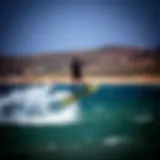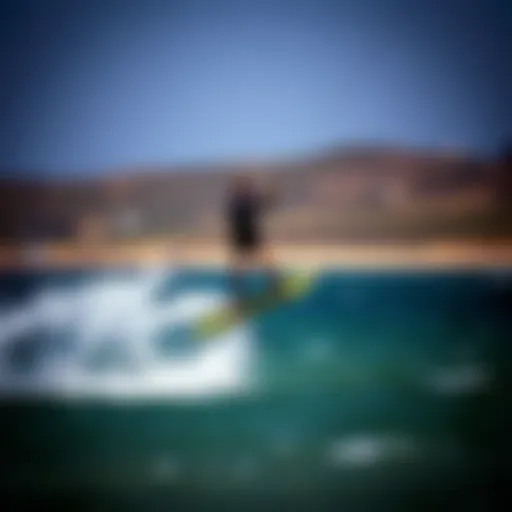Essential Insights into the 32 Wetsuit for Kiteboarding


Intro
Kiteboarding has seen its fair share of evolution, especially when it comes to the gear that supports this thrilling sport. One piece of equipment that holds significant importance is the wetsuit. The 32 wetsuit is crafted not only for protection against the chill of water but also to enhance performance and comfort. Selecting the right wetsuit is crucial, as it can mean the difference between a perfect day on the waves and battling through discomfort.
This guide serves as a comprehensive resource, tapping into various facets of the 32 wetsuit—from its construction materials to maintenance tips, helping kiteboarders make informed choices. Moreover, we will explore how these suits contribute to both safety and comfort, key elements for any adventurer looking to conquer the waves.
In a world where kiteboarders find themselves in constantly changing water conditions, the right wetsuit can provide a competitive edge, allowing for improved performance. With the right knowledge, an individual can not only select a wetsuit but also learn how to care for it, optimally adapting their gear for seasonal use. Let’s dive deeper into the world of wetsuits, starting off with some insights into the gear available today.
Gear Insights
The selection of wetsuits can feel overwhelming; names and technologies abound, making decisions appear daunting. But fear not—understanding the core features and having the right information in hand makes all the difference. Granular details such as the materials used and the design variations are worth exploring to sidestep regrettable purchases.
Latest Gear Reviews
When considering the 32 wetsuit, it’s vital to keep abreast of the latest gear reviews. Many experienced kiteboarders share their take on different brands such as O’Neill, Rip Curl, and Quiksilver on platforms like Reddit, giving real-world insights into the performance and durability of specific models. The latest iterations of these brands often showcase advancements in thermal insulation and flexibility, making it easier for kiteboarders to move freely while staying warm. Consult sources like Britannica.com or Wikipedia for a deeper understanding of the technological aspects surrounding wetsuits.
"The choice of a wetsuit can elevate your kiteboarding experience significantly. Invest in quality, and it will repay you time and again."
Essential Gear for Beginners
For newcomers to kiteboarding, the right wetsuit isn’t just a luxury; it's a necessity. Here are some tips and suggestions:
- Thickness: Look for wetsuits with a thickness of 3/2 mm or 4/3 mm depending on your local climate. Thinner suits are suitable for warmer waters, while thicker options are essential for colder temperatures.
- Fit: Ideally, the wetsuit should fit snugly without being restrictive. Gaps allow water to enter, chilling you quickly.
- Seams: Sealed seams or flatlock stitching can prevent water from leaking through, allowing for longer, more comfortable sessions.
A well-chosen wetsuit not only allows for prolonged enjoyment on the water but can also be a confidence booster. Knowing you’re well-equipped lets you focus on your performance instead of feeling like a popsicle halfway through a session.
Techniques and Tips
Advanced Tricks and Techniques
Mastering the intricacies of kiteboarding often goes hand in hand with having the right gear. The wetsuit becomes an extension of your body. Advanced kiteboarders find that flexibility and warmth can make a significant difference when executing difficult maneuvers.
Having a high-quality suit means better range of motion, allowing for sharper turns and tricks that require agility. Tips for enhancing your skills:
- Practice Regularly: Consistency is key in kiteboarding, and regular practice sharpens your abilities.
- Stay Aware of Conditions: Knowing how wind and water temperatures affect your performance can help determine what type of wetsuit to use.
Safety Practices for Kiteboarders
Safety is paramount in kiteboarding, and the right wetsuit contributes significantly. Here are practices to keep your adventures safe:
- Inspect Your Gear: Before each session, check for wear and tear on your wetsuit. Look for punctures or deterioration that could affect its insulation.
- Buddy System: Always kiteboard with a friend, as they can assist in emergencies where you might get tangled or experience difficulties.
Awareness and preparation can make a significant difference in the overall experience, enabling you to enjoy the thrill without the looming cloud of safety issues.
In summary, selecting the right wetsuit is all about balancing comfort, safety, and performance. The next section will synthesize the information gathered and provide a roadmap for choosing a wetsuit tailored to your individual needs, enhancing your kiteboarding journey.
Intro to Wetsuits
Wetsuits are not just pieces of clothing; they are vital in ensuring comfort and performance for water sports enthusiasts. In this guide, we delve into the ins and outs of wetsuits, highlighting their significance for kiteboarders, instructors, and all those drawn to the thrill of riding the waves. The importance of understanding your wetsuit cannot be understated. It can mean the difference between a thrilling day on the water and an uncomfortable ordeal.
For kiteboarding, a wetsuit goes beyond mere insulation. It supports mobility and agility, which are crucial for executing maneuvers effectively. As temps taper down, a well-fitted wetsuit also minimizes the risk of hypothermia. Additionally, understanding the various materials and technologies helps users make informed choices based on their unique needs and typical conditions they face in their kiteboarding adventures.
Understanding Wetsuits: Function and Purpose
Wetsuits serve multiple functions that go hand in hand with performance and safety. At their core, they trap a thin layer of water between the suit and the skin, which your body warms up, creating a barrier against the chill. However, a wetsuit does more than merely keep you warm.
- Buoyancy: The materials used in wetsuits, often neoprene, provide buoyancy, aiding in flotation while participating in water sports. This feature can be pivotal, especially for beginners.
- Protection: Whether it’s from sharp objects under the water, like rocks or coral, or from harmful UV rays, a wetsuit serves as armor against the elements.
- Agility: Contrary to misconceptions, modern wetsuits are designed to allow a range of movements, ensuring that users can perform without feeling restricted.


"Good wetsuits can be like your best friend out there—a reliable partner every time you hit the waves."
By investing in understanding wetsuits, you not only enhance your performance but also ensure a safer and more enjoyable experience on the water.
Historical Overview: Evolution of Wetsuit Design
The journey of the wetsuit is a fascinating tale of innovation born out of necessity. The early designs in the 1950s were quite rudimentary, often using simple rubber sheets. Surfers needed protection from the cold Pacific waters, and thus, a solution was crafted, albeit not without its flaws—think stiffness and discomfort.
As time marched on, materials began to improve significantly.
- Neoprene Development: The introduction of neoprene provided a stretchy, warm alternative to traditional rubber, aligning better with the movements of active users.
- Zipper Technology: Initially, wetsuits were difficult to put on. With advancements like the introduction of back zippers in the 1960s, it became easier to don and doff the suits.
- Computational Design: In recent years, technology has played a role in reshaping wetsuit design. Websites and apps that assist in fitting and sizing have made it more accessible to select an appropriate garment, ultimately enhancing experiences on the water.
As these changes continue to evolve, the design of wetsuits has not only been driven by function but also by aesthetics, catering to a visual culture that influences today's consumers. Understanding this evolution can aid users in comprehending their options better, leading to more informed purchases as they seek the right wetsuit for their kiteboarding needs.
The Wetsuit: A Detailed Examination
The 32 Wetsuit stands as a cornerstone in the world of aquatic sports, particularly for those who thrive on the waves, like kiteboarders. Its design and manufacturing are a blend of science and skill, tailored for both performance and comfort. This section dissects the numerous elements that make the 32 Wetsuit a standout choice, depicting its vital role in ensuring optimal performance while engaging in water sports.
Material Composition and Technology
The backbone of any wetsuit lies in its material. The 32 Wetsuit integrates advanced neoprene technology, which is a synthetic rubber known for its insulation and flexibility. The incorporation of limestone-based neoprene has been a game-changer in recent years. This material is not only eco-friendly but also provides more warmth and buoyancy than traditional petroleum-based neoprene. Its lightweight nature plays a significant role in facilitating agile movement, vital for activities such as kiteboarding.
Design Features of the Wetsuit
The architectural blueprint of the 32 Wetsuit encompasses several aspects, all designed to enhance user experience. Each feature is carefully crafted to address the demands of kiteboarding enthusiasts.
Stitch Technology
One of the key characteristics of the 32 Wetsuit is its stitch technology. Using a combination of flatlock and blind stitch methods, the seams are both strong and flexible. Flatlock stitching lays the threads flat against the skin, reducing chafing and making for a comfortable fit. Meanwhile, the blind stitch is employed in critical areas needing added waterproofing without sacrificing stretch.
The unique feature of this stitch method is its ability to combine durability and comfort, which is invaluable during prolonged wear. While some might argue that certain stitches can be less water-resistant than glued seams, the advanced hydrolysis-resistant coatings used in this wetsuit mitigate that concern, ensuring usability without compromising user comfort.
Zipper Configurations
Zipper configuration is another pivotal element in the design of the 32 Wetsuit. This wetsuit embraces a back zip configuration as well as a front zip option, catering to personal preference and convenience. The key characteristic of these zippers is their ease of entry and exit while maintaining a snug seal around the torso to minimize water infiltration.
Moreover, using high-quality zippers ensures longevity, preventing those frustrating moments of malfunction on the water. The specific feature that sets this wetsuit apart is the internal flap, which acts as an additional barrier against water entry, thus enhancing insulation. Potential drawbacks include a slightly bulkier feel with some zipper placements, but the benefits generally outweigh these issues for most users.
Insulation Methods
When it comes to insulation methods, the 32 Wetsuit excels in maintaining core body warmth even in chilly waters. The innovative use of thermal linings on the inside offers a soft texture that feels great against the skin, while still effectively retaining warmth. The incorporation of water-repellent technology not only aids in drying quickly but also prevents external cold water from penetrating the suit's fabric.
This insulating strategy is particularly advantageous for kiteboarders navigating unpredictable weather conditions, where regulatory warmth can significantly enhance performance. One of the few downsides might be that some users could feel slightly restricted in movement due to the thickness of the internal insulation layer, but this area can vary based on personal preference and fit.
In essence, the design of the 32 Wetsuit harmoniously combines materials that deliver high performance with features crafted for superior comfort and usability in water sports. Whether it's the advanced stitching, the thoughtful zipper placements, or the effective insulation methods, each aspect contributes to a wetsuit that meets the diverse needs of avid kiteboarders.
Advantages of Using the Wetsuit
When it comes to getting the most out of your time on the water, the right gear can make all the difference. The 32 wetsuit stands out for several reasons, particularly in kiteboarding—a sport that demands both performance and resilience. Understanding the benefits of the 32 wetsuit is essential to appreciate how it can positively influence your experience, whether you're catching waves or just gliding across the water.
Thermal Protection in Diverse Climates
One of the primary advantages of the 32 wetsuit is its ability to provide thermal protection across varying climates. Different water temperatures require different insulation strategies, and the 32 wetsuit excels in adapting to these needs.
- Cold Water Performance: For those who fancy braving chilly waves, the thicker neoprene used in the 32 wetsuit offers substantial insulation. This keeps the body warm even during extended periods in the water, reducing the risk of hypothermia.
- Warm Water Adaptability: On the opposite end, if you're in warmer waters, lighter versions of the wetsuit ensure you're not sweating buckets while trying to enjoy kiteboarding. The strategic design allows for breathability and quick drying, so you stay comfy regardless of conditions.
"The 32 wetsuit is your best bet for maintaining body warmth where water temps plunge. No one wants to cut their session short because of being too cold!"
In varying climates, a wetsuit that balances warmth and comfort can enhance your overall enjoyment and your performance when kiteboarding.


Enhanced Mobility for Kiteboarding
Kiteboarding is an exhilarating sport that combines thrill and finesse. The last thing you want is to feel restricted by your gear. The 32 wetsuit focuses on mobility, allowing for dynamic movement.
- Flexibility: Unlike stiffer wetsuits, the 32 model incorporates advanced seam technology and stretchy materials that enable a full range of motion. Whether you're launching off a wave or executing aerial tricks, the freedom of movement enhances your capability to perform.
- Streamlined Design: This wetsuit features a streamlined fit that reduces drag, allowing you to slice through water smoothly. A snug but comfortable fit means enhanced aerodynamics, making you more agile in the air and on the water.
Durability and Longevity Factors
Investing in a wetsuit isn't just about immediate performance; it's also about ensuring longevity. The 32 wetsuit is designed to withstand the rigors of frequent use and harsh conditions. Here are key points to consider:
- Robust Materials: Constructed from high-quality neoprene and reinforcing layers, the wetsuit resists wear and tear. It has been tested against the elements, meaning it won't fall apart after a few sessions.
- Repair Options: Should accidental damage occur, the 32 wetsuit comes with a good repair kit and user-friendly guidelines, extending its life beyond what many competitors offer.
By factoring in thermal protection, mobility, and durability, it becomes clear that the 32 wetsuit is tailored for those who are serious about their sport. Not only does it offer comfort, but its thoughtful design resonates with the needs of kiteboarders who often face a variety of conditions.
Choosing the Right Fit for Performance
Choosing the right fit for your wetsuit is often overlooked, yet it plays a pivotal role in ensuring optimal performance in the water. A wetsuit that fits well not only enhances comfort but also maximizes thermal protection and mobility, essential elements for kiteboarding and other water sports. When it comes to selecting a wetsuit, performance can vary dramatically based on how snugly it adheres to your body while allowing for sufficient movement. It's crucial to understand that a tight fit doesn't necessarily mean it's the right fit; it's a balance between comfort and functionality.
Sizing Guidelines for Optimal Comfort
Selecting the right size is an art rather than a science, but there are some guidelines that can help you navigate through this process effectively. First, it’s wise to refer to the manufacturer's sizing charts which typically consider height and weight as primary metrics. However, body shape plays a significant role as well. Here are some tips:
- Measure Yourself: Start by measuring your height, weight, chest, waist, and inseam. This gives a baseline to compare with size charts.
- Check Fit Type: Different wetsuits (e.g., full suits, spring suits) offer various fits. Full suits usually require a snug fit, while spring suits can afford a little more flexibility in size.
- Trial and Error: If possible, try on several sizes and styles to see which falls snugly against the skin without restricting movement.
- Look for Key Areas: Pay attention to areas like the armpits, shoulders, and knees while trying on a wetsuit. It should feel comfortable around these flexible joints without bunching.
Overall, it’s always better to err on the tighter side than too loose. If the suit feels like a second skin without constricting your movements, you've likely found your size.
Common Fit Issues and Solutions
Even after taking all the measurements, you may encounter some common fit issues that can affect your experience. Here are a few problems and their potential solutions:
- Too Tight in the Shoulders: A common complaint is tightness across the shoulders. If raised arms feel restricted, this signals that the fit isn’t ideal. Consider an alternative style with more stretch or possibly a different brand known for accommodating broader shoulder builds.
- Water Seepage: If water is constantly entering the suit, it may indicate that it’s too loose, especially around the neck and wrist areas. Look for suits with better sealing mechanisms or adjust the fit with a rash guard underneath.
- Discomfort at the Waist: An ill-fitting wetsuit often rides up or shifts uncomfortably, particularly in active movements like kiteboarding. A suit designed specifically for your activity might address snugness in the waist region, ensuring it stays in place.
- Pinch Points: If you notice pinched skin around critical areas, such as under the arms or behind the knees, that suit is not for you. Seek a wetsuit that offers a larger cut in these areas or is designed with more flexibility in mind.
Remember, the objective is a fit that allows for easy movement and warmth without compromising performance.
Overall, being aware of these common fit issues prepares you to make well-informed decisions as you choose your wetsuit. This diligence not only enhances your comfort but also ensures you can focus on your performance, rather than adjusting clothing that isn't quite right.
Caring for Your Wetsuit
Taking care of your 32 wetsuit is paramount for ensuring its longevity and maintaining its performance features. These suits are designed to provide insulation, flexibility, and comfort in water sports like kiteboarding, but they do require proper care to fulfill their purpose effectively. Neglecting maintenance can lead to wear and tear that may not only decrease performance but also affect your overall experience on the water. This guide focuses on cleaning, maintaining, and ultimately repairing your wetsuit, ensuring that it remains in peak condition no matter how many times you hit the waves.
Cleaning and Maintenance Practices
To keep your 32 wetsuit in top shape, it's essential to adhere to specific cleaning and maintenance practices. Here are some key points to consider:
- Rinse After Use: Always rinse your wetsuit with fresh water after every use. This simple act removes salt, sand, and chlorine, which can degrade the material over time.
- Avoid Direct Sunlight: When drying your wetsuit, avoid direct sunlight as UV rays can cause the neoprene to break down. Instead, hang it in a shaded area.
- Use Specialized Cleaners: Invest in a wetsuit cleaner rather than using standard detergents, which can leave residues and damage the material. Brands such as NRS Wetsuit Shampoo or Rip Curl Wetsuit Wash are designed to clean without harming.
- Store Properly: When not in use, store your wetsuit on a wide hanger to retain its shape. Avoid folding or crumpling it, as this can create permanent creases.
"Proper care is like a good recipe; the right ingredients and methods yield the best results."
Repair Techniques for Longevity
Even with the best care, accidents happen. Learning to repair your wetsuit can significantly extend its life. Here are few strategies:
- Inspect Regularly: After each use, inspect your wetsuit for any damages such as tears or seams that might be coming loose. Early detection makes fixing easier and prevents larger issues.
- Use Neoprene Cement: For small tears, neoprene cement is your best friend. Apply a small amount to both sides of the tear, allow it to sit for a few minutes, then press the sides together firmly.
- Patch Holes: For larger holes, purchasing a repair kit specifically designed for wetsuits can be beneficial. Cut a patch to size from the included neoprene, apply the cement, and then place the patch over the hole.
- Seek Professional Help: If the damage is extensive or beyond your skill level to mend, don't hesitate to consult a professional. Many shops offer repair services that can make your wetsuit good as new.
By following these care and repair guidelines, your 32 wetsuit will provide the necessary protection and comfort during your kiteboarding adventures for many seasons to come.
Contextual Suitability: When to Use the Wetsuit


Understanding when to don the 32 wetsuit is crucial for maximizing your experience, especially if you’re kiteboarding or engaging in other water sports. This section will shine a light on various circumstances that not only dictate the adequacy of the wetsuit but also enhance your overall performance and comfort in the water.
Seasonal Considerations and Recommendations
The seasons significantly affect the temperature of the water, which in turn dictates whether wearing the 32 wetsuit is advisable. Typically:
- Spring: As the water starts to warm, a 32 wetsuit can still provide necessary insulation, particularly during early spring when temperatures fluctuate between chilly and mild.
- Summer: For those hot July days, you might find a 32 wetsuit less appealing due to rising water temps. However, if you're venturing into cooler waters or facing wind chill, it serves as a perfect protective layer.
- Autumn: Again, water temperatures start to drop, and the 32 wetsuit helps maintain core warmth while kiteboarding during this transitional period.
- Winter: If you’re still out there in winter months, a 32 wetsuit allows you to surf or kiteboard without turning into an ice cube. Make sure to consider the thickness and thermal insulation that meets the chill.
Daily weather forecasts and local conditions can also make or break your decision. Be sure to check wind patterns and ambient temperatures; they're critical pieces of the puzzle.
Specific Water Conditions and Their Impact
Now, let’s dive into different bodies of water and their specific conditions. Each environment brings its own nuances that can affect your experience and what you need from your wetsuit.
- Choppy Waters: If you're on a day where the waves are all over the place, a quality 32 wetsuit can protect you against the inconsistent temperatures while also providing buoyancy needed to handle the rough surf.
- Flat Water: In contrast, if you’re whipping around in flat water, you might be tempted to ditch the wetsuit altogether. Still, a 32 can add an extra layer of protection against unexpected waves and wind.
- Cold Water: A no-brainer here, chilly waters scream for the insulation a 32 wetsuit provides. Optimal performance demands a suit that keeps you warm without weighing you down.
- Shallow Water: If you’re shallow kiting, the 32 wetsuit can safeguard against scrapes or bumps against rocks or reefs while still allowing for movement.
"Choosing the right wetsuit based on conditions can mean the difference between a great session and a regrettable one. A well-timed choice not only enhances performance but also prolongs your time in the water."
The importance of understanding contextual suitability cannot be overstated. A good 32 wetsuit ensures safety and comfort, especially in dynamic and ever-changing elemental conditions. This consideration will empower you on the water while still keeping you warm and ready to harness those winds.
Comparative Analysis with Other Wetsuits
When it comes to the world of kiteboarding, understanding how the 32 wetsuit stacks up against its competitors can be tremendously beneficial. Kiteboarders, instructors, and adventure-seekers all need gear that supports performance while ensuring safety and comfort. This section delves deep into the comparative landscape of wetsuits, shedding light on specific features and outcomes that make the 32 a compelling choice.
Performance Metrics: Versus Competitors
To accurately assess the prowess of the 32 wetsuit, it's vital to look at performance metrics that matter in various conditions. Consider the following aspects:
- Thermal Retention: The 32 wetsuit employs advanced insulation technologies that optimize heat retention even in chilly waters. Competitor wetsuits, although functional, often fall short in effectively sealing warmth, leading to discomfort.
- Flexibility and Mobility: With innovative fabric choices and ergonomic designs, the 32 wetsuit provides remarkable flexibility. Other brands might focus too heavily on durability at the expense of movement, which can hinder a kiteboarder's performance during those rapid maneuvers.
- Durability Factors: Wear and tear are inevitable when engaging with nature's elements, but the reinforced stitching and quality materials used in the 32 ensure it stands the test of time. Many rivals tend to fray or rip after just a few intense sessions, making longevity a crucial point of comparison.
- Weight and Buoyancy: The streamlined design of the 32 minimizes bulk without sacrificing buoyancy, allowing kiteboarders to stay agile on the water. In contrast, some alternative suits may be heavier, which can impede speed and agility.
"Choosing the right wetsuit isn't just about comfort; it's about performance and safety on the water."
These performance metrics highlight the advantages that the 32 brings to the table compared to its competitors. It's essential for consumers to weigh these factors carefully, as they directly impact the kiteboarding experience.
Best Practices for Selecting Alternatives
While the 32 wetsuit may stand out in several areas, many riders must consider alternatives based on personal preferences or unique conditions. When doing so, here are some best practices to remember:
- Assess Your Needs: Understand the specific conditions you'll be riding in—water temperature, wind conditions, and duration of sessions all play a role. Take a good look at brands like O'Neill or Rip Curl for colder climates or warmer, tropical entries like Xcel.
- Try Before You Buy: If possible, test out various models. A wetsuit might look great and fit well on the rack, but the real test comes when you're in the water.
- Read Reviews and Seek Insight: Platforms like Reddit and Facebook groups can offer real-world insights about others’ experiences with different brands and styles.
- Consider Seasonality: Some wetsuits are designed explicitly for winter or summer use. Brands often specify suitable temperature ranges, which can guide your decision.
- Don’t Overlook Fit: A proper fit is paramount. You want a snug suit that allows for movement without being restrictive. Poor fit can lead to chafing, discomfort, or loss of insulation.
Choosing the right wetsuit is more than just a purchase; it’s an investment in your kiteboarding adventures. Evaluating alternatives while grasping the distinct advantages of the 32 allows for informed decisions, tailoring your gear to your specific needs. By understanding comparative elements, riders can not only enhance their experience but also ensure they are safe and comfortable as they navigate the waters.
Ending and Final Thoughts
In wrapping up this comprehensive exploration of the 32 wetsuit, it’s crucial to understand its significance and the myriad benefits it brings to water sports, particularly kiteboarding. Throughout the article, we've examined how the technological advancements in wetsuit design profoundly influence performance, safety and comfort. With the popularity of kiteboarding surging around the globe, the role of a high-quality wetsuit like the 32 cannot be overstated.
When choosing a wetsuit, it’s not just about fitting into a standard size; it’s about selecting one tailored to specific environments and personal needs. This guide has highlighted important considerations such as material composition, thermal protection and design features which together create a reliable solution for enthusiasts and professionals alike.
The key takeaway? A well-chosen wetsuit ensures you can focus on the thrill of kiteboarding, whether you’re maneuvering through waves or gliding across calmer waters. In essence, investing in a high-performance wetsuit enhances both enjoyment and safety.
When it comes to performance, comfort, and safety, the right wetsuit can truly make a world of difference.
Summarizing Key Points
At this juncture, it’s beneficial to recap the cornerstone topics we covered:
- Understanding Wetsuits: We dove into how wetsuits function, their history and evolution, and how these factors dictate their effectiveness today.
- The 32 Wetsuit Features: We analyzed the materials and designs that define the 32 wetsuit, focusing specifically on innovations in stitching and insulation that play a vital role in enhancing performance.
- Advantages for Kiteboarders: Recognizing the importance of thermal protection, mobility, and durability gives kiteboarders the edge needed to navigate different water conditions efficiently.
- Fit and Performance: The right fit cannot be underestimated. Awareness of common sizing issues helps achieve the best usage out of your wetsuit.
- Maintenance: Proper care and repair techniques extend the life of your wetsuit, ensuring many adventures ahead.
- Contextual Suitability: Understanding when and where to use your wetsuit can dictate a successful outing on the water.
- Comparative Insights: Comparing the 32 wetsuit with other brands further highlights its merits, ensuring kiteboarders can make well-informed decisions.
Future Trends in Wetsuit Technology
The evolution of wetsuits is far from stagnation, with advancements continuing to evolve based on technological breakthroughs and environmental considerations. Several trends are worthy of mention:
- Eco-Friendly Materials: Increasingly, brands are turning to sustainable resources and eco-friendly production methods. This trend not only caters to environmentally conscious consumers but also addresses the larger issue of ocean health.
- Smart Wetsuits: The future might see wetsuits equipped with sensors that monitor body temperature, movement, and even biometric data, providing users with real-time feedback.
- Customization and Personalization: With advances in 3D printing and manufacturing technology, the possibility of custom-fit wetsuits tailored to individual shapes and preferences is on the horizon.
- Innovative Insulation: Future designs may incorporate lighter insulation materials that still provide substantial warmth, focusing on performance without compromising flexibility.
The prospects for wetsuit technology are exciting, and as these innovations unfold, kiteboarders can look forward to enhanced experiences and greater adaptations in their gear. As we continue navigating the vast waters of kiteboarding, understanding these trends encourages us to make smarter choices as consumers and adventurers alike.















